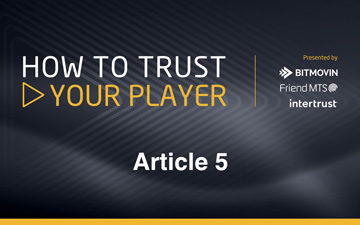
Article 5 – From One End to the Other: Protecting Content From Origination to Playback, Once and for All
Joshua Shulman, Digital Marketing Specialist, Bitmovin Alan Ogilvie, Lead Product Manager, Friend MTS Ali Hodjat, [...]
Watch our fireside chat or read the article below
Chris Cooke
Founder and Managing Director
CMU Insights
When the 2019 European Union Copyright Directive was being negotiated, one specific element of what was a wide-ranging set of copyright reforms captured most of the headlines, and that was the safe harbour reform contained in what was originally Article 13. And by the time the final stage of negotiations was underway, those safe harbour reforms were making headlines in the mainstream media as much as the trade press.
We might now see something similar happen in the US in the next year. Formal proposals were made in Congress in late 2020 that would reform the American version of the copyright safe harbour. One lobbying group has already dramatically declared that those proposed reforms would “create a system for digital copyright that is clearly unconstitutional and just unworkable for internet creators, users and service providers”.
So, what is the copyright safe harbour and why has the principle itself – and attempts to reform it – proven so controversial? Those are the questions we set out to answer in the first of a series of ‘Building Trust’ white papers.
The copyright safe harbour is a legal principle found in many countries that limits the liabilities of internet companies whose customers use their networks or servers to distribute other people’s copyright-protected content without permission.
Those companies can usually avoid liability for copyright infringement on their networks providing they fulfil certain obligations. They must have a system in place via which rights-holders can request that any infringing content be removed. And they must develop and enforce effective policies for dealing with repeat infringers among their user-base.
The basic principle is sound, and most rights-holders recognise why it is required, and how it has helped ensure the growth and evolution of a vibrant digital media and entertainment sector. However, many rights-holders nevertheless have issues with how the safe harbour has been implemented, and it’s those issues that have created the controversies.
For starters, there are concerns around the quality of the ‘takedown systems’ via which rights-holders can request that infringing content be removed.
The law often doesn’t provide much information on what those takedown systems should look like, and some argue that the courts have tended to set the bar too low when the quality of takedowns has come up in landmark cases.
Others say that safe harbour dwelling internet companies should actually be obliged to operate takedown-and-stay-down systems.
One current problem is that, even with good takedown systems, when infringing content is removed, another user often quickly re-uploads it. Many rights-holders say that, once a takedown has been issued in relation to any one piece of content, the internet company should not only remove it once, but also ensure that it never reappears on its platform.
Concerns have also been raised about takedown systems from a totally different group of stakeholders. They point out that under copyright law there are certain scenarios where people can make use of copyright-protected material without getting permission. In the US that is enabled by a principle called ‘fair use’.
Are those copyright exceptions being properly considered when takedowns are issued and content removed? And as automated systems are increasingly used for takedowns, can technology understand something as nuanced as fair use?
Concerns have also been raised about the quality of the repeat infringer policies. Some internet companies have been accused of having repeat infringer policies that seem to comply with their safe harbour obligations, but then not properly enforcing them.
This issue has been at the heart of some major court cases in the US that have arguably set a precedent that safe harbour dwelling companies need to ensure repeat infringer policies definitely are being enforced, or risk being held liable for their users’ infringement.
And finally there is the issue that the controversial Article 13 of the EU Copyright Directive – or Article 17 in the final draft – sought to address.
That is the use of safe harbour protection by user-upload platforms that arguably compete with other digital media, music and video services for subscribers and advertisers, but which often approach licensing differently, because of the safe harbour.
Some rights-holders argue that user-upload platforms should never have had safe harbour protection and – at the very least – should have to meet extra obligations to enjoy such protection. Article 17 introduces extra obligations of that kind.
So, plenty of issues, causing plenty of controversies. And as the Copyright Directive gets properly implemented across Europe, while US lawmakers start to consider those proposed reforms of the American safe harbour, the controversies will continue.
To be fully informed on all sides of these ongoing debates, download your free copy of the ‘Building Trust’ white paper on safe harbour.
Check out the other article in this series:
The Harmful Content Challenge: Tackling Online Harms While Protecting Freedom of Speech

Joshua Shulman, Digital Marketing Specialist, Bitmovin Alan Ogilvie, Lead Product Manager, Friend MTS Ali Hodjat, [...]
Friend MTS Limited
177 Shaftesbury Avenue
London
WC2H 8JR
UK: +44 203 588 2111
US: +1 267 382 4280
© 2024 Friend MTS Limited | All Rights Reserved